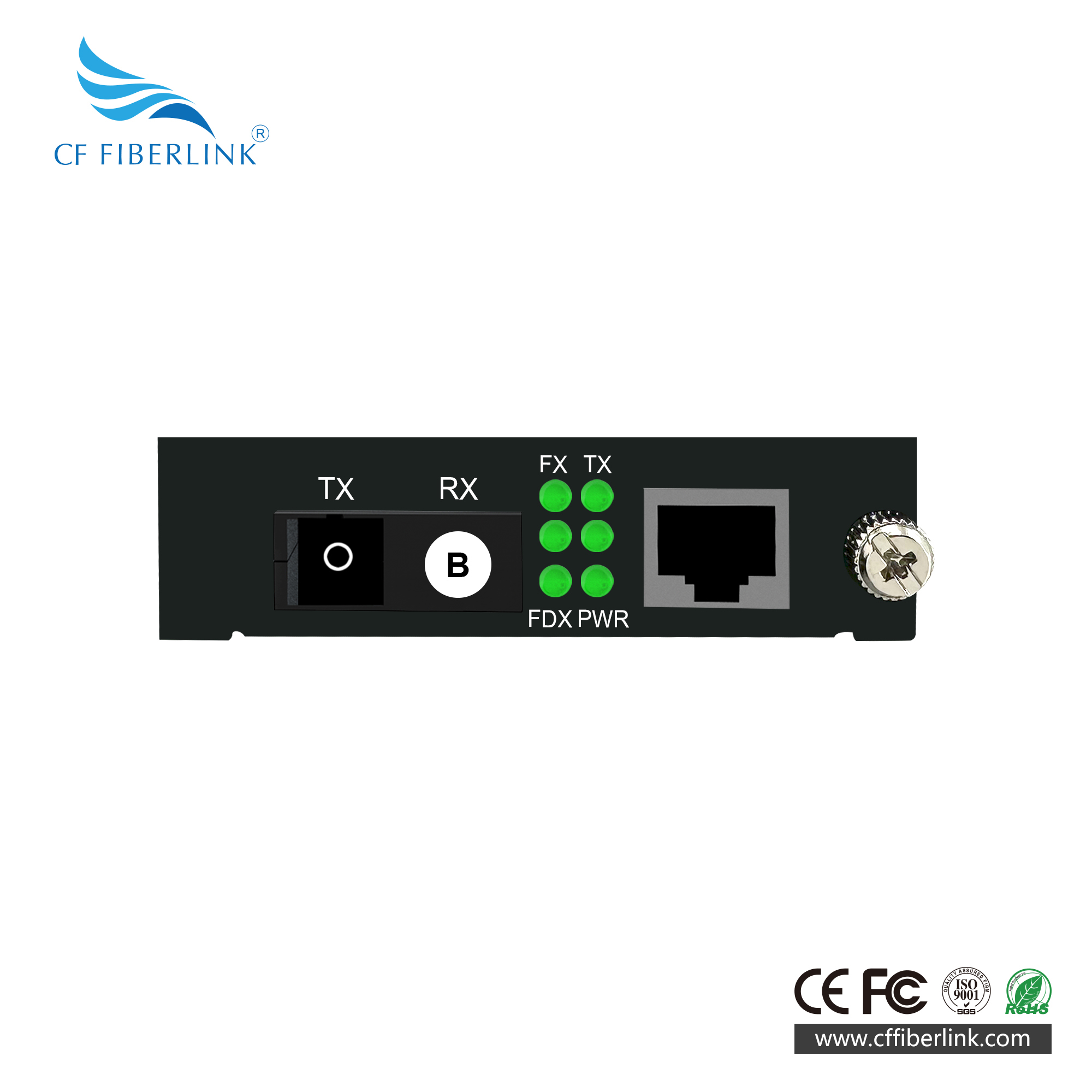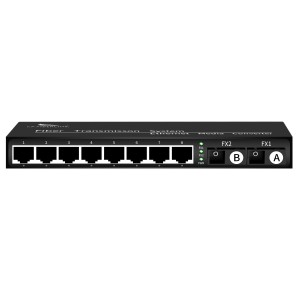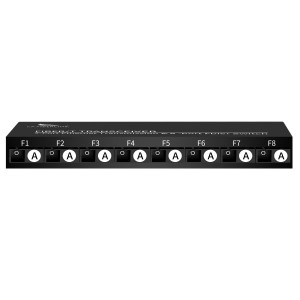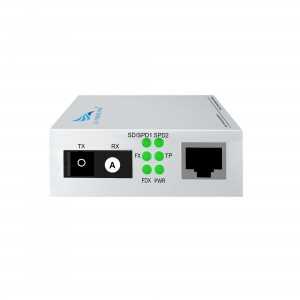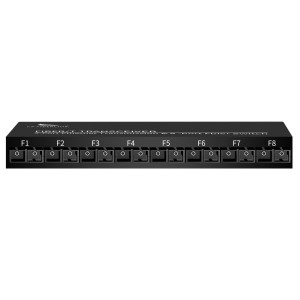2-port 10/100/1000M WDM Media Converter (Single-mode Single-fiber SC)
2-port 10/100/1000M WDM Media Converter (Single-mode Single-fiber SC)
Product Features:
Launched cutting-edge card-type 1 optical 1 electrical single-mode single-fiber transceiver
Huizhou Changfei Optoelectronics Technology Co., Ltd. proudly presents our latest product innovation – Card 1 Optical 1 Electrical Single Mode Single Fiber Transceiver. As a leading high-tech enterprise focusing on bridges and optical modules, we are constantly striving to provide high-quality solutions for data centers, and this new optical fiber module is no exception.
Our MSA Compatible Card Type 1 Light 1 Electrical Singlemode Single Fiber Transceivers are designed to provide unrivaled performance and reliability in data center environments. With its compact size and powerful features, this transceiver is the perfect choice for networking professionals looking for seamless and efficient connectivity.
One of the outstanding features of our products is their wide voltage supply range. Our transceivers are powered by DC5-12V, which ensures uninterrupted power supply and minimizes potential interruptions and downtime. This enables smooth and consistent data transfer, improving overall network performance.
Additionally, our Card Type 1 Optical 1 Electrical Single Mode Single Fiber Transceiver provides robust lightning strike protection. All ports of the transceiver are equipped with 4KV lightning protection, providing advanced protection measures to ensure the safety and service life of the data center infrastructure.
Our transceivers are designed to withstand extreme temperatures and perform flawlessly over a wide temperature range. From hot summer days to cold winter months, our products perform at their best, ensuring a stable and reliable connection for your critical applications.
Additionally, our transceivers support 10KB jumbo frames for efficient transmission of large data packets. This feature is especially beneficial for data centers that handle massive information flows, such as multimedia streaming or cloud computing. With our transceivers, you can get lightning-fast data transfer speeds and increase network efficiency.
Last but not least, our Card Type 1 Optical 1 Electrical Single Mode Single Fiber Transceiver boasts incredibly low power consumption. By minimizing energy usage, our products not only contribute to environmental sustainability, but also help reduce operating costs for data center operators.
In conclusion, Huizhou Changfei Optoelectronics Technology Co., Ltd. is proud to present our Card 1 Optical 1 Electrical Single Mode Single Fiber Transceiver. With its compact size, MSA compliance, and advanced features such as wide voltage power supply, lightning protection, wide temperature operation, jumbo frame support, and low power consumption, this transceiver is the perfect solution for your data center needs.
Invest in our innovative and reliable products today and experience uninterrupted high-performance connectivity in your data center infrastructure. Please believe that Huizhou Changfei Photoelectric Technology Co., Ltd. can provide cutting-edge solutions for your network needs.
What This Product Does
◇ CF-101GSK-20B is a gigabit media converter, providing a gigabit RJ-45 port and a gigabit SC fiber port, which can convert between electrical and optical signals.
How This Product Works
◇ CF-101GSK-20B adopts WDM (wavelength division multiplexing) technology, helping send and receive data at a distance of up to 20 km with only a single mode fiber, which saves half of the cable deployment cost for customers. CF-101GSK-20B transmits data at 1310 nm wavelength and receives data at 1550 nm wavelength on optical fiber. Therefore, the terminal device used in conjunction with the CF-101GSK-20B should send data at a wavelength of 1550 nm and receive data at a wavelength of 1310 nm. CF FIBERLINK another media converter CF-101GSK-20A is one of the products that can cooperate with CF-101GSK-20B.
Other Features
◇ Besides, this media converter can be used as a standalone device (no rack required) or used with CF FIBERLINK’s CF-2U16 rack for auto MDI/MDI-X in TX port in which duplex mode is automatically negotiated.
technical parameter:
|
Model |
CF-101GSK-20B | |
| Interface Characteristics | ||
|
Fixed Port |
1* 10/ 100/ 1000Base-T RJ45 port 1* 1000Base-X uplink SC fiber port |
|
|
Ethernet Port |
10/ 100/ 1000Base-T auto-sensing, full/half duplex MDI/MDI-X self-adaption |
|
|
Twisted Pair Transmission |
10BASE-T: Cat3,4,5 UTP(≤100 meter) 100BASE-T: Cat5e or later UTP(≤100 meter) 1000BASE-T : Cat5e or later UTP(≤100 meter) |
|
| Optical Port | Default optical module is single-mode single-fiber 20km, SC port | |
| Wavelength/Distance | A-end: RX1310nm / RX1550nm 0 ~ 40KM
B-end:RX1550nm/ RX1310nm 0 ~ 40KM |
|
| A-end: RX1490nm / RX1550nm 0 ~ 120KM
B-end:RX1550nm/ RX1490nm 0 ~ 120KM |
||
| Chip Parameter | ||
| Network Protocol | IEEE802.3 10BASE-T, IEEE802.3i 10Base-T,
IEEE802.3u 100Base-TX, IEEE802.3u 100Base-FX, IEEE802.3x IEEE802.3ab 1000Base-T;IEEE802.3z 1000Base-X; |
|
|
Forwarding Mode |
Store and Forward(Full Wire Speed) |
|
|
Switching Capacity |
4Gbps |
|
|
Buffer Memory |
3Mpps | |
|
MAC |
2K | |
|
LED Indicator |
Fiber | FX(green) |
| Data | TP (green) | |
| Single / duplex | FDX (green) | |
| Power | PWR (green) | |
| Power | ||
| Working Voltage |
AC:100-240V |
|
|
Power Consumption |
Standby<1W, Full load<5W |
|
|
Power Supply |
DC:5V/2A industrial power supply |
|
| Lightning protection &Certification | ||
| Lightning protection | Lightning protection: 4KV 8/20us, Protection level: IP30 | |
| Certification | CCC;CE mark, commercial; CE/LVD EN60950;FCC Part 15 Class B; RoHS | |
| Physical Parameter | ||
| Operation TEMP | -20~+55°C;5%~90% RH Non condensing | |
| Storage TEMP |
-40~+85°C;5%~95% RH Non condensing |
|
| Dimension (L*W*H) | 98mm*75mm*2mm | |
| Installation | Desktop, CF-2U16 slot rack | |
Product Size:
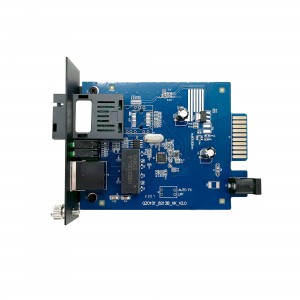
Product application diagra:

How to choose a fiber optic transceiver?
Optical fiber transceivers break the 100-meter limitation of Ethernet cables in data transmission. Relying on high-performance switching chips and large-capacity caches, while truly achieving non-blocking transmission and switching performance, they also provide balanced traffic, isolation and conflict. Error detection and other functions ensure high security and stability during data transmission. Therefore, fiber optic transceiver products will still be an indispensable part of actual network construction for a long time. So, how should we choose fiber optic transceivers?
1. Port function test
Mainly test whether each port can work normally in the duplex state of 10Mbps, 100Mbps and half-duplex state. At the same time, it should be tested whether each port can automatically select the highest transmission speed and automatically match the transmission rate of other devices. This test can be included in other tests.
2. Compatibility test
It mainly tests the connection ability between the optical fiber transceiver and other devices compatible with Ethernet and Fast Ethernet (including network card, HUB, Switch, optical network card, and optical switch). The requirement must be able to support the connection of compatible products.
3. Cable connection characteristics
Test the fiber optic transceiver’s ability to support network cables. First, test the connection ability of Category 5 network cables with lengths of 100m and 10m, and test the connection ability of long Category 5 network cables (120m) of different brands. During the test, the optical port of the transceiver is required to have a connection capability of 10Mbps and a rate of 100Mbps, and the highest must be able to connect to a full-duplex 100Mbps without transmission errors. Category 3 twisted pair cables may not be tested. Subtests can be included in other tests.
4. Transmission characteristics (transmission loss rate of data packets of different lengths, transmission speed)
It mainly tests the packet loss rate when the optical fiber transceiver optical port transmits different data packets, and the connection speed under different connection rates. For the packet loss rate, you can use the test software provided by the network card to test the packet loss rate when the packet size is 64, 512, 1518, 128 (optional) and 1000 (optional) bytes under different connection rates. , the number of packet errors, the number of packets sent and received must be more than 2,000,000. Test transmission speed can use perform3, ping and other software.
5. The compatibility of the whole machine to the transmission network protocol
It mainly tests the compatibility of fiber optic transceivers to network protocols, which can be tested in Novell, Windows and other environments. The following low-level network protocols such as TCP/IP, IPX, NETBIOS, DHCP, etc. must be tested, and the protocols that need to be broadcast must be tested. Optical transceivers are required to support these protocols (VLAN, QOS, COS, etc.).
6. Indicator status test
Test whether the status of the indicator light is consistent with the description of the panel and the user manual, and whether it is consistent with the current status of the fiber optic transceiver.






